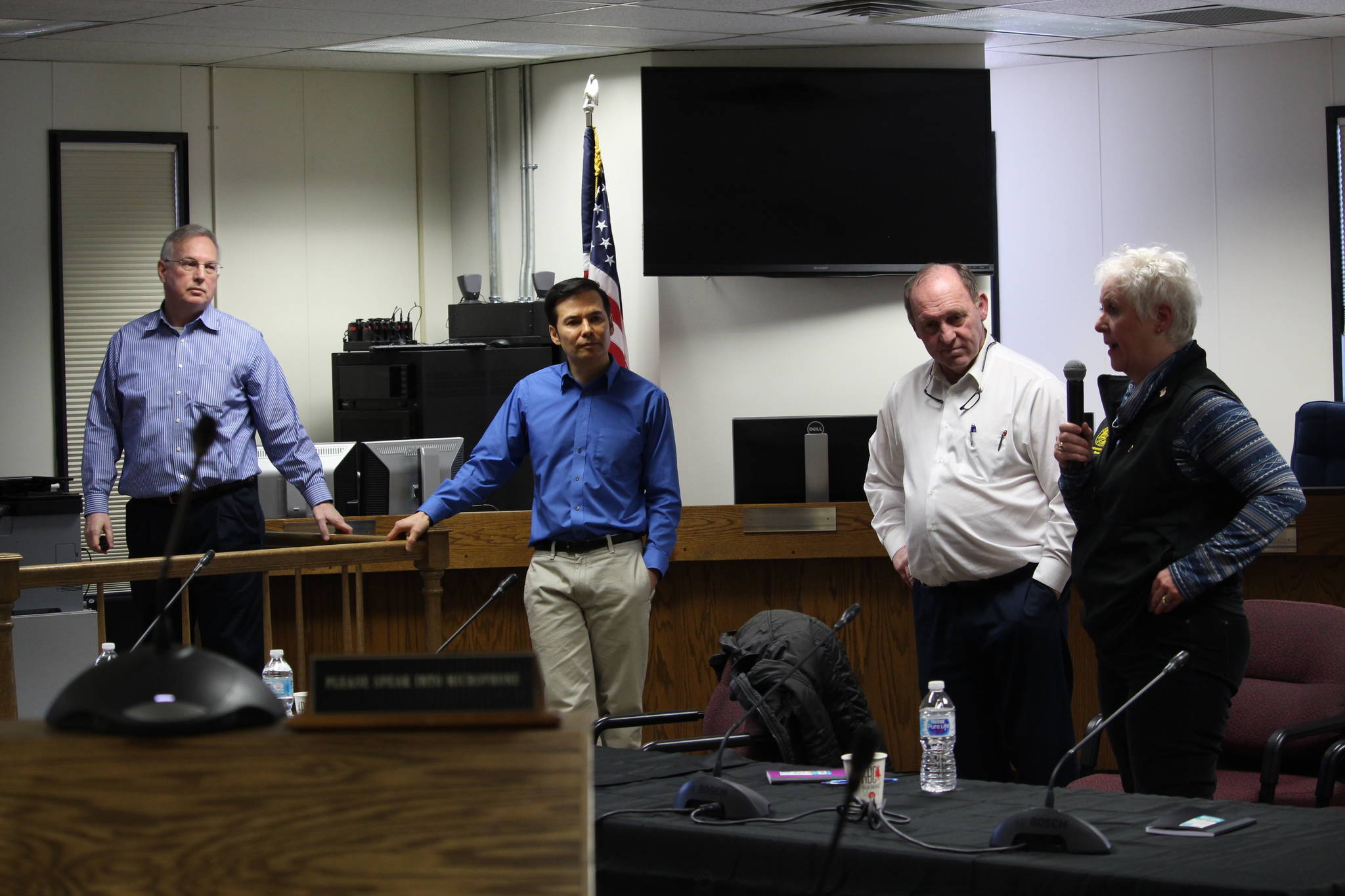This article has been updated. Majority Whip Louise Stutes is a Republican representing Kodiak.
As Alaska’s House of Representatives continue to work out the state’s budget for the coming year, Rep. Gary Knopp, R-Kenai, took a break from Juneau and visited Soldotna on Saturday with some of his fellow House members to discuss the state’s fiscal reality with his constituents.
Knopp, along with House Speaker Bryce Edgmon, I-Dillingham, Majority Whip Louise Stutes, R-Kodiak, and Rep. Neal Foster, D-Nome, spent a few hours in the Kenai Peninsula Borough Assembly Chambers to give a presentation on the options for long-term funding of Alaska’s government services and the future of the Alaska Permanent Fund dividend.
The main takeaway from Saturday’s presentation was this: The four lawmakers believe that Alaska’s best bet for long-term financial security involves substantially growing the permanent fund and using its earnings to fund government services, acknowledging that revenue from the oil and gas industry will no longer be the primary revenue stream.
The combination of relatively low oil prices and low production, Foster said, means that lawmakers have to look elsewhere for the funds necessary for Alaska’s state services, like education, health and social services, roads and public safety.
“Up until a few years ago, oil made up for 90% of the state’s revenue,” Foster said. “Now the earnings from the permanent fund are, I believe, about two-thirds of our state’s revenue.”
Alaska hit its peak for oil production in 1988 at over 2 million barrels per day, according to the U.S. Energy Information Administration. By 2018 production had dropped to about 479,000 barrels per day, and Edgmon said that the 10-year forecasts given to legislators indicate that production will remain at about 500,000 barrels a day for the near future.
“In the future, we’re going to have a state government that’s going to be funded in large part from the earnings of the permanent fund,” Edgmon said. “But hopefully, you know, we’re going to have a steady supply of oil revenue to supplement that.”
The permanent fund is managed by the Alaska Permanent Fund Corporation and receives an average annual return on its investments of about 7%, according to the lawmakers’ presentation, with a portion of its annual earnings put into the Earnings Reserve Account. The principal of the permanent fund cannot be appropriated to pay for state services. The money for the permanent fund dividend, as well as the money used to pay for state services, is drawn from the ERA.
Knopp said that he and his fellow lawmakers would like to continue drawing about 5% of the permanent fund balance from the ERA in order to pay for the PFD and the state’s budget, and for the last few years they have used about 5.25% of the fund annually. The total balance of the permanent fund, including the principal and the ERA, is about $66.98 billion as of Dec. 31, 2019, and Edgmon said that the board of trustees of the Permanent Fund Corporation have set a 10-year goal of increasing the permanent fund’s balance to $85 billion by 2030.
“Personally I’m very supportive of doing this because I want this permanent fund to get big enough to where we could have the will to be able to provide all the services we need, provide as big of a permanent fund dividend as possible, and keep Alaska a low-tax environment,” Edgmon said.
Long-term investment in Alaska’s fiscal future, the lawmakers argued, could mean short-term cuts to the annual payout of the permanent fund dividend. A dividend payout the size that Gov. Mike Dunleavy has proposed — about $3,000 per Alaskan — would mean that legislators would either have to draw about $1.5 billion from the state’s Constitutional Budget Reserve, increase revenue through new taxes, or cut state expenditures by a similar amount to make up for the revenue shortfall.
“That’s the intersection that we’re at in Juneau,” Edgmon said.
“I’ve been asked many times, what size PFD should we have?” Knopp said. “And I’ve said we should have the PFD that we can afford.”
During their presentation and afterwards, the lawmakers heard questions and comments from peninsula residents about what they would like to see during this year’s legislative session.
Some in attendance were in favor of a smaller PFD in exchange for long-term financial stability, while others believed that the state should privatize some of its services — namely The University of Alaska, the Alaska Marine Highway System and the Alaska Railroad — in order to reduce expenditures and ensure a full PFD payout for residents.
The House version of the state’s budget is still being discussed within the subcommittees of the House Finance Committee, of which Knopp is a member and Foster is the co-chair. Knopp said that he expects the budget to be on the floor of the House by around March 3 for deliberation and voting.

